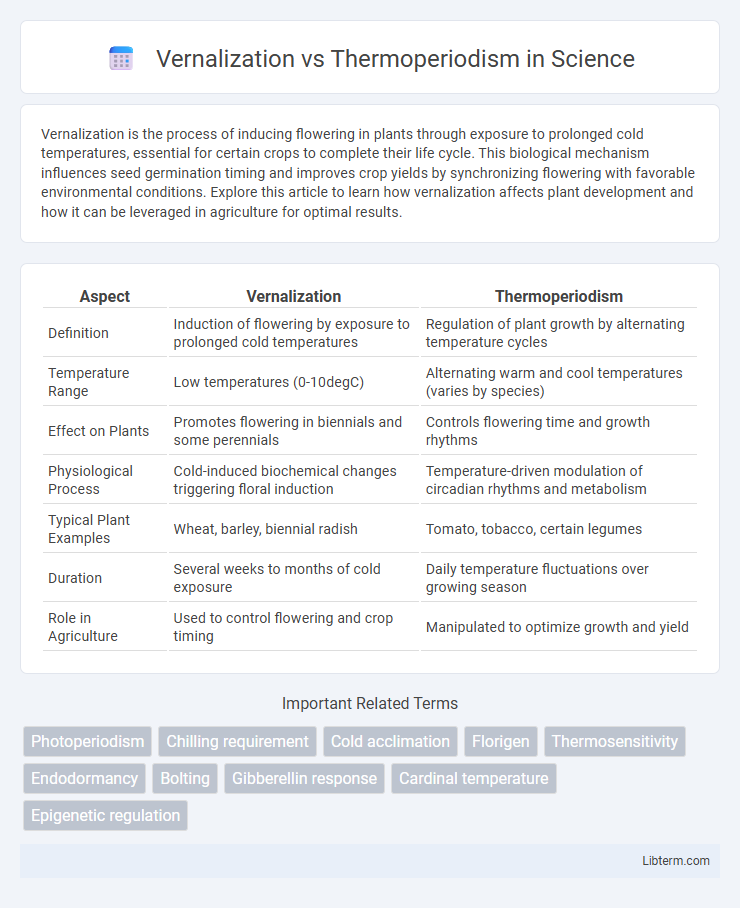Vernalization is the process of inducing flowering in plants through exposure to prolonged cold temperatures, essential for certain crops to complete their life cycle. This biological mechanism influences seed germination timing and improves crop yields by synchronizing flowering with favorable environmental conditions. Explore this article to learn how vernalization affects plant development and how it can be leveraged in agriculture for optimal results.
Table of Comparison
| Aspect | Vernalization | Thermoperiodism |
|---|---|---|
| Definition | Induction of flowering by exposure to prolonged cold temperatures | Regulation of plant growth by alternating temperature cycles |
| Temperature Range | Low temperatures (0-10degC) | Alternating warm and cool temperatures (varies by species) |
| Effect on Plants | Promotes flowering in biennials and some perennials | Controls flowering time and growth rhythms |
| Physiological Process | Cold-induced biochemical changes triggering floral induction | Temperature-driven modulation of circadian rhythms and metabolism |
| Typical Plant Examples | Wheat, barley, biennial radish | Tomato, tobacco, certain legumes |
| Duration | Several weeks to months of cold exposure | Daily temperature fluctuations over growing season |
| Role in Agriculture | Used to control flowering and crop timing | Manipulated to optimize growth and yield |
Introduction to Vernalization and Thermoperiodism
Vernalization is the exposure of plants to prolonged cold temperatures to induce flowering, a crucial mechanism in species adapted to cold climates such as winter wheat and biennial plants. Thermoperiodism refers to the physiological response of plants to alternating temperatures within a 24-hour period, influencing processes like growth rate and flowering time in crops like tomatoes and rice. Understanding both vernalization and thermoperiodism is key to optimizing agricultural practices and improving crop yields under varying climatic conditions.
Defining Vernalization: Key Concepts
Vernalization is the exposure of plants to prolonged cold temperatures to induce flowering, essential for many temperate crop species like wheat and barley. This physiological process ensures that plants flower only after experiencing winter, thus optimizing reproductive success and yield. Key concepts include the requirement of a critical chilling period and the epigenetic regulation of flowering genes, such as VRN1 in cereals.
Understanding Thermoperiodism: Basic Principles
Thermoperiodism refers to the influence of alternating temperature cycles on plant growth and development, where specific temperature ranges during day and night regulate physiological processes. Unlike vernalization, which requires prolonged exposure to cold for flowering induction, thermoperiodism involves the sensitivity of plants to daily temperature fluctuations affecting flowering time, germination, and enzyme activity. Understanding thermoperiodism enables optimization of crop production by manipulating temperature regimes to enhance growth, yield, and stress tolerance in various plant species.
Mechanisms Behind Vernalization
Vernalization involves the exposure of plants to prolonged cold temperatures to trigger flowering by inducing epigenetic changes that repress flowering inhibitors such as the FLOWERING LOCUS C (FLC) gene in Arabidopsis. This cold-induced mechanism ensures that flowering occurs only after winter, enhancing reproductive success by synchronizing development with favorable conditions. In contrast, thermoperiodism refers to the differential response of plants to day and night temperature variations, affecting growth rates and flowering time without the necessity of prolonged cold exposure.
How Thermoperiodism Regulates Plant Growth
Thermoperiodism regulates plant growth by exposing plants to alternating temperatures during the day and night, which influences processes such as seed germination, flowering, and leaf development. This temperature variation activates specific genes and metabolic pathways that control circadian rhythms and hormone levels, optimizing growth under fluctuating environmental conditions. Unlike vernalization, which requires prolonged cold exposure to induce flowering, thermoperiodism fine-tunes growth responses to daily temperature cycles, enhancing adaptability and development in diverse climates.
Key Differences Between Vernalization and Thermoperiodism
Vernalization is the process by which prolonged exposure to low temperatures induces flowering in plants, whereas thermoperiodism refers to the differential growth response to fluctuating day and night temperatures. Vernalization typically involves a cold treatment period essential for breaking seed or bud dormancy, while thermoperiodism influences daily physiological activities such as leaf expansion and stem elongation through temperature variations. The key difference lies in vernalization's role in developmental phase transition compared to thermoperiodism's regulation of growth rhythms within existing developmental stages.
Biological Significance in Agriculture
Vernalization accelerates flowering in crops like wheat and barley by exposing seeds or plants to prolonged cold, ensuring flowering occurs at optimal seasonal times, which increases yield stability in temperate regions. Thermoperiodism regulates plant growth and developmental processes by responding to daily temperature fluctuations, enhancing crop adaptability to diverse climates and improving pest and disease resistance. Understanding these mechanisms enables precise manipulation of planting schedules and crop varieties, optimizing agricultural productivity and sustainability.
Examples of Vernalization in Crop Plants
Vernalization is the exposure of seeds or plants to prolonged cold temperatures to induce flowering, essential in crops like winter wheat, barley, and rye where cold treatment accelerates reproductive development. Thermoperiodism, contrastingly, involves plant responses to alternating day and night temperatures affecting growth and flowering without requiring chilling. In winter wheat, vernalization enables flowering after winter, ensuring crops complete growth cycles in favorable conditions, underscoring its critical role in temperate agriculture.
Practical Applications of Thermoperiodism
Thermoperiodism plays a critical role in optimizing crop yield by regulating plant growth cycles through specific temperature fluctuations, enhancing flowering and fruiting efficiency. In greenhouse cultivation, precise control of day-night temperature variations improves seedling vigor and crop quality for species like tomatoes and cucumbers. Understanding thermoperiodism allows farmers to manipulate environmental conditions to synchronize development stages, resulting in improved productivity and resource use.
Future Research and Innovations in Plant Adaptation
Emerging research on vernalization and thermoperiodism explores gene-editing technologies like CRISPR to enhance crop resilience against climate variability by precisely manipulating flowering time genes. Advances in molecular phenotyping and transcriptomics enable deeper understanding of temperature-induced epigenetic changes, facilitating the development of varieties optimized for shifting seasonal patterns. Integrating AI-driven predictive models with genomic data accelerates breeding programs targeting improved adaptation to fluctuating thermal environments.
Vernalization Infographic

 libterm.com
libterm.com